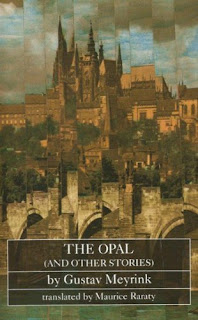The Opal and Other Stories
 The Opal and Other Stories, by Gustav Meyrink
The Opal and Other Stories, by Gustav MeyrinkHere's another book I found at the university library. I actually looked for The Green Face, because although I have that on my Kindle, I've been finding it difficult to get into. I figured if I got started with the physical book, maybe I could then read the rest on Kindle. Well, I didn't only find The Green Face -- right next to it was this collection of short stories that doesn't seem to be in print any more in the US (you can get it on Kindle though). So I grabbed that and read it...and I did get enough time to read the first few chapters of Green Face as well, and my plan worked. I'm now well into that novel.
So this is a collection of Meyrink's early short stories, written right at the beginning of the 1900s, before he wrote any novels. (His later novel, The Golem, is what made him famous. I've now also read Walpurgisnacht. ) At this time, he's trying and failing to make a living as a banker in Prague. Meyrink hated Prague, and he wasn't a big fan of some other things, too. In these stories, he really pours some venom on army officers and their 'code of honor' (remember, this is German culture right before World War I, so these would be Prussian officers), and also upon doctors, who are lampooned as pompous quacks. Which they probably were -- again, this is about 1900. And one other thing -- Meyrink was very interested in Eastern religions, in the occult, pretty much anything that wasn't boring old Christianity.
The anti-officer sentiment in these stories led to their banning in 1916 in Austria. Meyrink became the focus of nationalist attacks (in print) that sound more than a little hysterical to modern readers -- he was "blamed for lack of progress in the War" and also for attacking German womanhood.
The stories:
"Petroleum, Petroleum" is a prophetic satire that is possibly more horrifying to the modern reader than it was originally -- it was written in 1903 -- in which a mad scientist floods the oceans of Earth with a layer of crude oil. It satirizes absolutely everybody, including telegrams:
...the verbatim telegram from along the Mexican Gulf coast, abbreviated according to the international cable code: "EXPLOSION CALFBRAIN BERRYMUSH" which approximately translates as 'Seasurface completely covered in oil; cause unknown, everything stinks. State governor.'The solution is to dissolve the army. Regular soldiers all have skills and can get jobs, and the useless officers can soak up the oil with blotting paper.
This interested the Yankees enormously, as the occurrence was without a doubt bound to make a great impression on the stock exchange and to push up the value of petroleum shares.
"The Black Ball," another prophetic horror story, features two Indian yogis who use an apparatus to focus their thoughts into semi-permanent images. They wow the crowd, and others try:
It was in fact only the images projected by the mathematicians that were at all clear. By contrast, the results excogitated by heads of juridical capacity were most peculiar. General amazement and a universal shaking of heads, however, greeted the concentrated effort of that famous practitioner of Internal Medicine, Professor Mauldrescher. Even the solemn Asiatics were amazed: an incredible jumble of small, discoloured lumps appeared in the glass, followed by a mass of blurry blobs and points.But then an officer tries it...and creates a black hole that will, very slowly, eat the universe.
(As a matter of fact, Meyrink seems to have invented the idea of a black hole all on his own. This was written in 1913, a few years before Einstein published.)
"Dr. Lederer" starts off with an event that terrifies the populace: a glowing disk of light appears in the sky, with the silhouette of a monster in it.
A chameleon, a chameleon! horrible.He's poking fun at mob hysteria, but I think it comes off even sillier now than he meant it to be. He didn't know about the Bat Signal, after all. And I have to wonder if he really meant the cute little chameleon, or some scarier lizard? Though I suppose in 1900 maybe chameleons looked pretty outlandish to Europeans. And finally, for Tick fans, the whole thing can't help but evoke the Crusading Chameleon!
 |
| The Crusading Chameleon! |
In a spooky description of a haunted church, we have:
Prayersnails! ...mysterious outlines of women's veiled heads superimposed on cold, slimy snail bodies, with black, catholic eyes, sucking noiselessly across the chill pavement.
There are also several scattered stories featuring the evil genius Dr. Daryashkoh, who changes his victims into horrible living machines or monsters through magic and vivisection. I suppose he's a bit like that hokey old horror movie villain, the Reanimator, though Dr. Daryashkoh's creations are really scary.
It surprises me that these stories are not more well known and published in spooky collections along with Blackwood, Machen, James, le Fanu, and all those other early horror writers. Some of these would fit right in. Maybe because they weren't written in English? Possibly the translations aren't out of copyright yet, or something. Anyway, connoisseurs of scary stories would love these.




Comments
Post a Comment
I'd love to know what you think, so please comment!